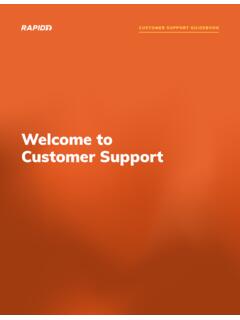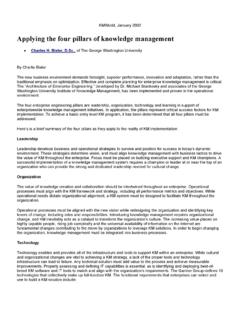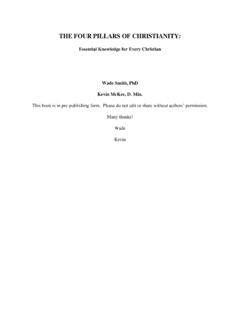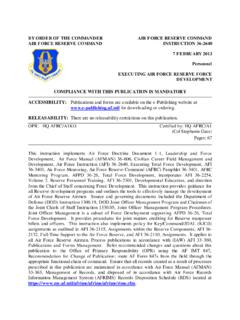Transcription of WHITEPAPER THE FOUR PILLARS OF MODERN …
1 WHITEPAPER4 Key PILLARS of MODERN Vulnerability Risk ManagementA comprehensive approach to reducing vulnerabilities across your ecosystem4 Key PILLARS of MODERN Vulnerability Risk Management2 TABLE OF CONTENTSI ntroduction 3 Enhancing Network Vulnerability Assessment 4 Addressing Web Application Vulnerabilities 6 Mitigating User Risk 8 Assessing Risk to Prioritize Remediation 9 Conclusion 114 Key PILLARS of MODERN Vulnerability Risk Management3 Time for a new perspectiveA decade ago, most enterprises could get away with addressing vulnerabilities in silos. One team would scan servers and desktop computers on the enterprise network, looking for misconfigurations in systems and vulnerabilities in commercial software applications.
2 When problems were discovered, they were thrown over the wall for system administrators and operations groups to developers were responsible for policing inter-nally developed web applications. Other specialists worried about the susceptibility of employees to social engineering attacks. Rarely was anyone responsible for analyzing how different types of vulnerabilities might interact to expose critical data and intellectual vision of vulnerability management is too inefficient and expensive for today s enterprise. Computing environ-ments are far more complex. IT and security groups must monitor a much larger attack surface.
3 Infrastructures and web applications can change on a daily, even hourly basis. Cybercriminals and hackers have learned how to exploit chains of weaknesses in systems, applications, and people. Traditional vulnerability management tools and practices are too limited, too siloed, and too slow to keep up with these organizations must rethink their vulnerability management programs to monitor dynamic computing environments, respond in minutes, and address weaknesses in people as well as a MODERN vulnerability risk management programSecurity organizations must rethink their vulnerability management programs.
4 They need to monitor complex, dynamic computing environments, and respond in minutes or hours when issues are discovered not days or weeks. They need to address weaknesses in people as well as technology. Also, security professionals must be able to think like attackers in order to understand which vulnerabili-ties pose the greatest risks to the this WHITEPAPER , we will explore how enterprises can address these challenges and evolve toward a MODERN vul-nerability risk management program using shared visibility, analytics, and automation. We will discuss how they can: Enhance traditional network vulnerability assessment to handle more complex computing infrastructures Achieve complete ecosystem visibility Strengthen their ability to test complex, rapidly changing web applications Increase resilience to phishing and other social engineering attacks Use penetration testing to assess overall risk and better prioritize remediation effortsIntroduction: The Traditional Vision of Vulnerability Management Is Outdated4 Key PILLARS of MODERN Vulnerability Risk Management4 Network vulnerability assessment is changing.
5 It is time to think about complete ecosystem is no longer enough to scan the corporate network quarterly or monthly for vulnerabilities on servers and desktops. Security teams must be able to monitor the entire attack surface, including cloud platforms and virtualized and containerized environ-ments. Even more, they need to cope with the dynamic nature of these environments, where new instances of applications and services can be spun up on virtual machines at a moment s notice. Operational issues are part of the picture, too. Because teams need to monitor more data on more types of endpoints and platforms, they have to minimize the number of new endpoint agents and assessment tools.
6 If different tools are used for each computing platform, it becomes difficult to share data and achieve single pane of glass visibility. Finally, organizations need to ensure that vulnerabilities, once detected, can be remediated quickly, before they can be exploited by ecosystem visibilityOne of the key principles for a MODERN vulnerability risk management program and the overarching practice of SecOps is complete ecosystem visibility. That means integrating vulnerability assessment scanning solutions with virtual services like VMWare, and with Infrastructure as a Service (IaaS) platforms such as AWS and Azure.
7 Why?This integration enables the organization to obtain immediate insight into risks created by changes in the computing infrastruc-ture. For example, in virtual environments, a vulnerability assessment agent can be embedded in the images of your instances. That way, every time a new component of the service is spun up, it can be scanned for vulnerabilities. This eliminates the window of exposure that would other-wise last until the vulnerability was detected in the next scheduled scan. Complete ecosystem visibility involves integrating vulnerability assessment scanning solutions with virtual services, as well as IaaS platforms, applications, and other cloud environments pose a special challenge, because security organizations often aren t informed when new infrastructure is deployed on IaaS platforms.
8 Vulnerability assessment tools can be integrated with AWS, Azure, and other cloud platforms to detect when new devices are deployed and automatically assess them. They can also ensure that golden images are hardened before deployment. For additional visibility, agents can be embedded in these images just as with virtual Network Vulnerability AssessmentEnterprises today need to step up their game4 Key PILLARS of MODERN Vulnerability Risk Management5 Simplified assessmentSecurity teams should be able to monitor more types of data on more types of endpoints without multiplying the number of agents and assessment solutions they use.
9 However, many devices have limited connectivity to the corporate network. Several are too sensitive to be scanned by traditional assessment methods, or require credentials that security may be hesitant to broadcast widely. But there is a solution: MODERN agents that can safely assess these devices, and send data back securely to a central vulnerability assessment tool. A universal agent can make this approach even more scalable and sustainable by collecting a wide range of data from systems, endpoints, and virtual machines, and by sharing the results with multiple vulnerability assessment solutions.
10 Integrating scanning tools with internal ticketing systems automates the handoff of vulnerability tasks to the IT operations team, giving them access to more data, faster, with less chance of losing remediation workflowsThe third key to agile vulnerability risk management is the automation of remediation workflows. Integrating scanning tools with internal ticketing systems automates the handoff of vulnerability data and tasks to the IT operations team. This automated handoff gives operations teams access to more data, faster, with less chance of crucial information being lost. It enables them to patch systems and fix misconfigurations quickly and accurately.












